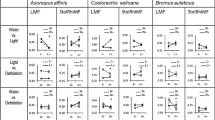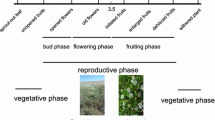Abstract
Plant responses to herbivory are complex. In grasses, relative growth rate (RGR), seed, and vegetative reproduction, resource allocation, and architecture vary differentially and often nonlinearly with grazing intensity. High grazing tolerance may be achieved through compensatory photosynthesis and leaf growth, or through demographic mechanisms such as activation of a belowground dormant bud bank. This study assessed the relationship between grazing frequency and responses of Schizachyrium scoparium (little bluestem) in a tallgrass prairie, and examined the roles of tiller growth, reproduction, and bud (meristem) populations in its persistence under grazing. Genets were subjected to varying simulated grazing frequencies for a period of 2 years. Strong differential responses were observed among plant traits. RGR, biomass, and flowering showed strong nonlinear reductions in response to increasing clipping frequency, with no evidence of threshold effects. However, meristem density was unaffected, and plants maintained a large bud bank across all clipping treatments. Tiller natality decreased initially, but increased with >4 clippings, suggesting that declines in tiller RGR are partially offset by increasing tiller natality, and that variation in genet size is driven more by demography than by variation in individual tiller growth. Increased grazing frequency also resulted in differential activation of buds at different positions (emerging within vs. outside the subtending leaf sheath), explaining the shift to a more prostrate growth form observed in many caespitose grasses under persistent grazing. Thus, although this grass species lacks the capacity for compensatory foliage re-growth, the maintenance of a large dormant bud bank and the differential activation of buds in different positions contribute to its grazing tolerance and avoidance, respectively, and its long-term persistence in grazed grasslands.







Similar content being viewed by others
Reference
Benson E, Hartnett DC (2006) The role of seed and vegetative reproduction in plant recruitment and demography in tallgrass prairie. Plant Ecol 187:163–177
Benson E, Hartnett DC, Mann K (2004) Belowground bud banks and meristem limitation in tallgrass prairie plant populations. Am J Bot 91:416–421
Briske DD (1991) Developmental morphology and physiology of grasses. In: Heitschmidt RK, Stuth JW (eds) Grazing management: an ecological perspective. Timber Press, Portland, pp 85–108
Brown JR, Stuth JW (1993) How herbivory affects grazing tolerant and sensitive grasses in a central Texas grassland: integrating plant response across hierarchical levels. Oikos 67:291–298
Butler JL, Briske DD (1988) Population structure and tiller demography of the bunchgrass Schizachyrium scoparium in response to herbivory. Oikos 51:306–312
Cingolini AM, Posse G, Collantes MB (2005) Plant functional traits, herbivore selectivity and response to sheep grazing in Patagonian steppe grasslands. J Appl Ecol 42:50–59
Dalgleish HJ, Hartnett DC (2009) The effects of fire frequency and grazing on tallgrass prairie plant composition and productivity are mediated through bud bank demography. Plant Ecol 201:411–420
Dannell K, Bergstrom R, Duncan P, Pastor J (2006) Large herbivore ecology, ecosystem dynamics and conservation. Cambridge University Press, Cambridge, p 522
de Mazancourt C, Loreau M, Abbadie L (1998) Grazing optimization and nutrient cycling: when do herbivores enhance plant production? Ecology 79:2242–2252
Del-Val E, Crawley MJ (2005) Are grazing increaser species better tolerators than decreasers? an experimental assessment of defoliation tolerance in eight British grassland species. J Ecol 93:1005–1016
Derner JD, Gillen RL, McCollum FT, Tate KW (1994) Little bluestem tiller defoliation patterns under continuous and rotational grazing. J Range Manag 47:220–225
Dwyer DD, Elder WC, Single G (1963) Effects of height and frequency of clipping on pure stands of range grasses in north central Oklahoma, Oklahoma Agric Exp Bull 614
Fair J, Lauenroth WK, Coffin D (1999) Demography of Bouteloua gracilis in a mixed prairie: analysis of genets and individuals. J Ecol 87:233–243
Fuhlendorf SD, Engle DM (2001) Restoring heterogeneity on rangelands: ecosystem management based on evolutionary grazing patterns. Bioscience 51:625–632
Gillen RL, McCollum FT, Brummer JE (1990) Tiller defoliation patterns under short duration grazing in tallgrass prairie. J Range Manag 43:95–99
Gutman M, Noy-Meir I, Pluda D, Seligman NA, Rothman S, Sternberg M (2001) Biomass partitioning following defoliation of annual and perennial Mediterranean grasses. Conserv Ecol 5:1: http://www.consecol.org/Journal/vol5/iss2/art1
Harper JL (1977) Population biology of plants. Academic Press, London, p 892
Hartnett DC, Setshogo MP, Dalgleish HJ (2006) Bud banks of perennial savanna grasses in Botswana. Afr J Ecol 44:256–263
Knapp AK, Briggs J, Hartnett DC, Collins SL (eds) (1998) Grassland dynamics: long-term ecological research in tallgrass prairie. Oxford University Press, New York, p 336
Kotanen PM, Bergelson J (2000) Effects of simulated grazing on different genotypes of Bouteloua gracilis: how important is morphology? Oecologia 123:66–74
Leriche H, Le Roux X, Desnoyers F, Simioni G, Abbadie L (2003) Grass response to clipping in an African savanna: testing the grazing optimization hypothesis. Ecol Appl 13:1346–1354
Maschinski J, Whitman TG (1989) The continuum of plant responses to herbivory: the influence of plant association, nutrient availability and timing. Am Nat 134:1–19
Maurico R, Rausher MD, Burdick DS (1997) Variation in the defense strategies of plants: are resistance and tolerance mutually exclusive? Ecology 78:1301–1311
Mullahey JJ, Waller SS, Moser LE (1990) Defoliation effects on production and morphological development of little bluestem. J Range Manag 43:497–500
Mullahey JJ, Waller SS, Moser LE (1991) Defoliation effects on yield and bud and tiller numbers of two sand hills grasses. J Range Manag 44:241–245
N’Guessan M (2007) Effects of grazing on growth and morphology of rhizomatous and caespitose grasses. Thesis, Kansas State University
Olson BE, Richards JH (1988) Tussock regrowth after grazing: intercalary meristem and bud activity of tillers of Agropyron desertorum. Oikos 51:374–382
Peters DPC (2002) Recruitment potential of two perennial grasses with different growth forms at a semiarid-arid transition zone. Am J Bot 89:1616–1623
Pfeiffer KE, Hartnett DC (1995) Bison selectivity and grazing responses of little bluestem in tallgrass prairie. J Range Manag 48:26–31
Rogers W, Hartnett DC (2001) Temporal vegetation dynamics and recolonization mechanisms on different-sized soil disturbances in tallgrass prairie. Am J Bot 88:1634–1642
Rusch GM, Skarpe C, Halley DJ (2009) Plant traits link hypothesis about resource-use and response to herbivory. Basic Appl Ecol 10:466–474
Sala OE (2001) Temperate grasslands. In: Chapin FS III, Sala OE, Huber-Sannwald E (eds) Global biodiversity in a changing environment. Scenarios for the 21st century, ecological studies 152. Springer, New York
Seliskar DM (2003) The response of Ammophila breviligulata and Spartina patens (Poaceae) to grazing by feral horses on a dynamic mid-Atlantic barrier island. Am J Bot 90:1038–1044
Spasojevic MJ, Aicher RJ, Koch GR, Marquardt ES, Mirotchnick N, Troxler TG, Collins SL (2010) Fire and grazing in a mesic tallgrass prairie: impacts on plant species and functional traits. Ecology 91:1651–1659
Trlica MJ, Rittenhouse LR (1993) Grazing and plant performance. Ecol Appl 3:21–23
Tuomi J, Nilsson P, Astrom M (1994) Plant compensatory responses: bud dormancy as an adaptation to herbivory. Ecology 75:1429–1436
Turner CL, Seastedt TR, Dyer MI (1993) Maximization of aboveground grassland production: the role of defoliation frequency, intensity, and history. Ecol Appl 3:175–186
Veen (Ciska) GF, Blair JM, Smith MD, Collins SL (2008) Influence of grazing and fire frequency on small-scale plant community structure and resource variability in native tallgrass prairie. Oikos 117:859–866
Vesk PA, Westoby M (2004) Funding the bud bank: a review of the cost of buds. Oikos 106:200–208
Vinton MA, Hartnett DC (1992) Effects of bison grazing on Andropogon gerardii and Panicum virgatum in burned and unburned tallgrass prairie. Oecologia 90:374–382
Williams DG, Briske DD (1991) Size and ecological significance of the physiological individual in the bunchgrass Schizachyrium scoparium. Oikos 62:41–47
Acknowledgments
This research was partially supported by the National Science Foundation Long-Term Ecological Research Program (IBN-9632851), and the US Department of Agriculture Rangeland Research Program (Grant No. 00310306).
Author information
Authors and Affiliations
Corresponding author
Rights and permissions
About this article
Cite this article
N’Guessan, M., Hartnett, D.C. Differential responses to defoliation frequency in little bluestem (Schizachyrium scoparium) in tallgrass prairie: implications for herbivory tolerance and avoidance. Plant Ecol 212, 1275–1285 (2011). https://doi.org/10.1007/s11258-011-9904-4
Received:
Accepted:
Published:
Issue Date:
DOI: https://doi.org/10.1007/s11258-011-9904-4




